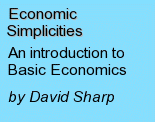

|
|
INTRODUCTION TO ECONOMICS
Lesson 31
Vietnam
Present day Vietnam, [formally the Socialist
Republic of Vietnam], is a country of approximately 84 million people
located in the south and east of the Indo-China Peninsula, which it
shares with Laos, Cambodia and Thailand.
The area is 329,560 sq km. As
a comparison, the area of Victoria is 237,629 sq km, which makes Vietnam
about one and a third times the size of Victoria.
Ethnically, the population is predominantly
Vietnamese [87%]. There are
significant populations of tribal people in the mountains [Montagnards],
Cambodians and Laotians along their respective borders and Chinese in
the cities. Perhaps less than 60% of the land area [albeit the most
productive part] is occupied by ethnic Vietnamese, with the remainder
occupied largely by minorities.
The country is bordered by China in the north and
by Laos and Cambodia in the west. It
has a coastline in the east to the Gulf of Tonkin and the South China
Sea and in the west to the Gulf of Thailand.
Climate in the south is tropical, ie hot and humid, albeit cooler
in the mountains. In the
north it is warm-temperate and monsoonal ie with seasonal prevailing
winds and rain.
Vietnam extends roughly north south.
In shape it is somewhat like an upright dumbbell.
It encompasses five principal geographic zones; mountains along
the China border, 2 large deltas, that of the Red River in the north [in
which the capital Hanoi is located] and the Mekong in the south, and a
mountainous spine and coastal plain connecting the two.
At its narrowest point the country is only 50 kms wide.
HISTORY
The history of a land and the history of its
people do not necessarily coincide, as Vietnam demonstrates.
The Vietnamese people are thought to have originated from a
fusion of an Australo-Melanesian people then inhabiting the Red River
delta and Asiatic people immigrating into the area from south China,
which occurred at least several thousand years ago, wherefrom the
Vietnamese evolved. Studies
of the Vietnamese language, which is distinctive, support such theory.
From approximately the second century BC the
Vietnamese were occupied by the Chinese.
Yet they retained their identity and continued to resist.
In 938 AD they succeeded in regaining their independence.
They also began to expand to the south.
What is now central Vietnam then comprised the Kingdom of Champa.
Over the next few centuries the Sinacised Vietnamese destroyed
this kingdom and virtually annihilated the Indianised Chams. [Today
about 77,000 survive in Vietnam divided into 2 communities; Hindu &
Muslim].
The
territory to the south of Champa formed part of the Khmer or Cambodian
empire. Following the
destruction of Champa, the Vietnamese gradually pushed the Cambodians
out of this part of what is now Vietnam and occupied it.
Paradoxically it was the arrival of the French in 1858 who
proceeded then to occupy Vietnam [along with Cambodia and Laos, in
combination to form French Indo-China], that probably saved the
Cambodians from a similar fate to that which befell the Chams.
During the French colonial period Vietnam was
divided into 3 component parts; Tonkin in the north, essentially
comprising the Red River delta, Cochin China in the south, essentially
comprising the Mekong delta, and Annam, the long, mountainous and
relatively narrow strip connecting the two.
Although such division is seemingly officially frowned upon in
present day Vietnam, [perhaps from a fear of national fragmentation],
there is some basis therefor, with the people from each of the three
regions being to a greater or lesser extent distinguished from the other
2.
In
1940 the Japanese invaded and took control.
The Vietnamese resisted the Japanese and when the Japanese were
defeated in WW 2, resisted the French when they tried to re-establish
their former control. The
French were defeated and withdrew in 1954 but thereafter the Americans
[supported by various allies, including Australia] sought to set up an
independent South Vietnam. This
too failed. The Americans withdrew their military assistance in 1973 and
this was followed shortly thereafter by the collapse of the separate
South Vietnamese state in 1975 and the establishment of a unified
communist Vietnam, with its capital at Hanoi.
The former southern capital, Saigon, was renamed Ho Chi Minh City
in honour of the victorious leader..
ECONOMY
The current viewpoint on the Vietnamese economy
seemingly depends in many instances on the sympathy or lack thereof of
the relevant economist or commentator for the country, its people or its
government.
Following the successful conclusion of the war,
the government of the newly unified country imposed strict Marxist
economic policies and became part of Comecom, the Soviet trading bloc.
This tended to inhibit economic development.
Following the collapse of the Soviet Union Vietnam was forced to
liberalise its trade and economic policies, which saw a significant
improvement in economic performance. Exports in particular expanded significantly resulting in a
trade surplus. Growth of 9%
per annum was recorded from 1993-7.
The 1997 Asian crisis saw it fall to 4% in 1998-9. It
has since risen to about 7%.
Following
the Asian crisis the government drew back from implementing economic
liberalisation and largely opted for economic and political stability. Considerable growth has occurred in agricultural production
[Vietnam is now the second biggest rice exporter] and there has been
significant growth in manufacturing foodstuffs, clothing, silk and
marine products. However
heavy industry such as cement, coal and steel are stagnant and there is
much unemployment and poverty.
Presently the banking system is a shambles and
administrative and legal obstacles are discouraging foreign
investment. Some foreign
experts are suggesting that without some major changes the Vietnamese
economy could slip into reverse.
1966 …….!
David Sharp
August
2005
Return to the Home Page
|
|




